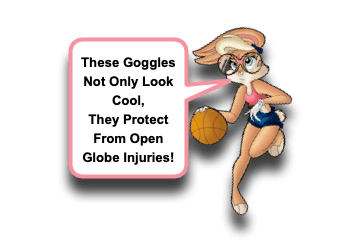Open Globe Injuries in Children

Injuries and accidents happen. Sometimes they are minor and other times, sadly, they can be major. The impact of those injuries is often relate to the location of the injury. We have covered many traumatic injury issues previously, but ocular injuries deserve some extra attention. While we have addressed traumatic iritis and eyelid lacerations, we need to digest a Morsel on another important injury – Open Globe Injuries:
Open Globe Injuries: Basics
- Eye trauma is the leading cause of monocular blindness worldwide. [Li, 2015]
- Open globe injuries refer to a full-thickness injury to the cornea and/or sclera. [Li, 2015]
- Two Types of Open Globe Injuries: [AlDahash, 2020; Li, 2015]
- Ruptures
- Due to BLUNT trauma.
- Full-thickness defect at the weakest point in the eye wall.
- Second most common form of open globe injury.
- Lacerations
- Due to a SHARP object entering the globe.
- Can be classified as:
- Penetrating –
- Only one wound
- The MOST COMMON form of open globe injury.
- Perforating –
- Has separate entrance and exit wounds
- Least common form of open globe injury.
- Penetrating –
- Intraocular Foreign Bodies are also possible and need specific attention.
- Ruptures
- Categorized by zone involvement: [Li, 2015]
- Zone 1 = cornea and limbus; most common.
- Zone 2 = extends from limbus to anterior 5 mm of sclera
- Zone 3 = areas posterior to the zone 2 (ie, deeper); associated with worse prognosis.
- Causes of pediatric open globe injuries: [Read, 2016; Li, 2015]
- Sharp objects (like Glass) are most frequent cause.
- Fireworks are also common worldwide.
- Abuse and/or Assault
- Possible Complications: [Li, 2015]
- Amblyopia / Impaired vision
- Endophthalmitis
- Vitreous Hemorrhage
- Corneal Opacities
- Foreign Body Toxicity
- Sympathetic Ophthalmia
- Rare, but leads to complete blindness
- Autoimmune response leading to granulomatous inflammation of BOTH eyes
- Factors known to indicate poor visual prognosis: [AlDahash, 2020; Li, 2015; Bunting, 2013]
- Younger ages (< 5 years)
- Poor initial visual acuity
- Globe rupture
- Posterior chamber involvement
- Long wound length
- Lens involvement
- Vitreous hemorrhage
- Retinal Detachment
- Endophthalmitis
Open Globe Injuries: Evaluation
- Check ABCDEs first!
- Just like the broken arm or leg, don’t get distracted by the obviously grotesque injury.
- Do primary and secondary surveys to evaluate for other concomitant injuries.
- History matters. [Li, 2015]
- An intraocular foreign body may not be obvious on exam.
- History of explosion, projectiles, or sharp objects should increase your concern for foreign bodies.
- Examination matters… but can be challenging. [Li, 2015]
- If there is an obvious open globe injury;
- Keep child comfortable.
- Attempt to get best assessment without struggling with the child.
- May require covert assessments.
- Protect the eye with a rigid eye shield.
- Call ophthalmologist.
- Keep child comfortable.
- If you have concern for open globe injury;
- Keep the child comfortable (still important)
- Attempt to assess for:
- Degree of ocular mobility
- Afferent Pupillary Defect
- Deficits in Confrontational Visual Fields
- Visual Acuity
- Use slit-lamp (portable slit-lamp may be necessary) to evaluate the components of the eye.
- Some children may require sedation or exam under anesthesia.
- Have high concern for OCCULT laceration if you find:
- Hemorrhagic chemosis
- Abnormally shallow or deep anterior chamber
- Peaked / Asymmetric pupil
- Intraocular pressure of < 10 mmHg (do not check if you have obvious open globe injury)
- Other signs to look for:
- Vitreous Hemorrhage
- Hyphema
- Uveal/Vitreous Prolapse
- Lens Subluxation
- If there is an obvious open globe injury;
- Imaging can help you see… [Li, 2015]
- While the primary diagnosis is made by history and examination, imaging may also be necessary in cases that are not as obvious and/or to evaluate for foreign bodies.
- Ultrasound
- Can be done at bedside.
- Should not be done if high concern for open globe injuries.
- Can assess for intraocular foreign bodies.
- CT
- Can assess for intraocular foreign bodies.
- Can assess other concomitant injuries (ex, facial fractures)
- CT may be less reliable in small patients compared to adult-sized. [Dikci, 2019]
- MRI
- Should NOT be used until possible metal foreign bodies have been ruled-out.
- Can help discriminate any ambiguous hypodenisities seen on CT that may be wood.
- Management: [Li, 2015]
- Open globe injuries require emergent reposition of prolapses contents, debridement, and primary wound closure (not by me… by our friendly eyeball doctors!).
- In the ED, we need to:
- Protect the eye with a rigid eye shield.
- Give broad spectrum antibiotics (ex, Cefazolin or Ceftazidime and Vancomycin)
- Update Tetanus status.
- Keep child comfortable and limit activity.
Moral of the Morsel
- Eye trauma is due to trauma… so don’t overlook other injuries! Be thorough and assess your ABCDEs with primary and secondary surveys!
- Don’t wrestle! Keeping the child calm and comfortable is important to help avoid worsening the globe injury.
- Protect the eye! Rigid eye shield to the rescue! Ensure that the edges are on surround bony structures… not pushing on the globe.
- Antibiotics and Anti-Tetanus! Simple, but easy to forget… so don’t.

